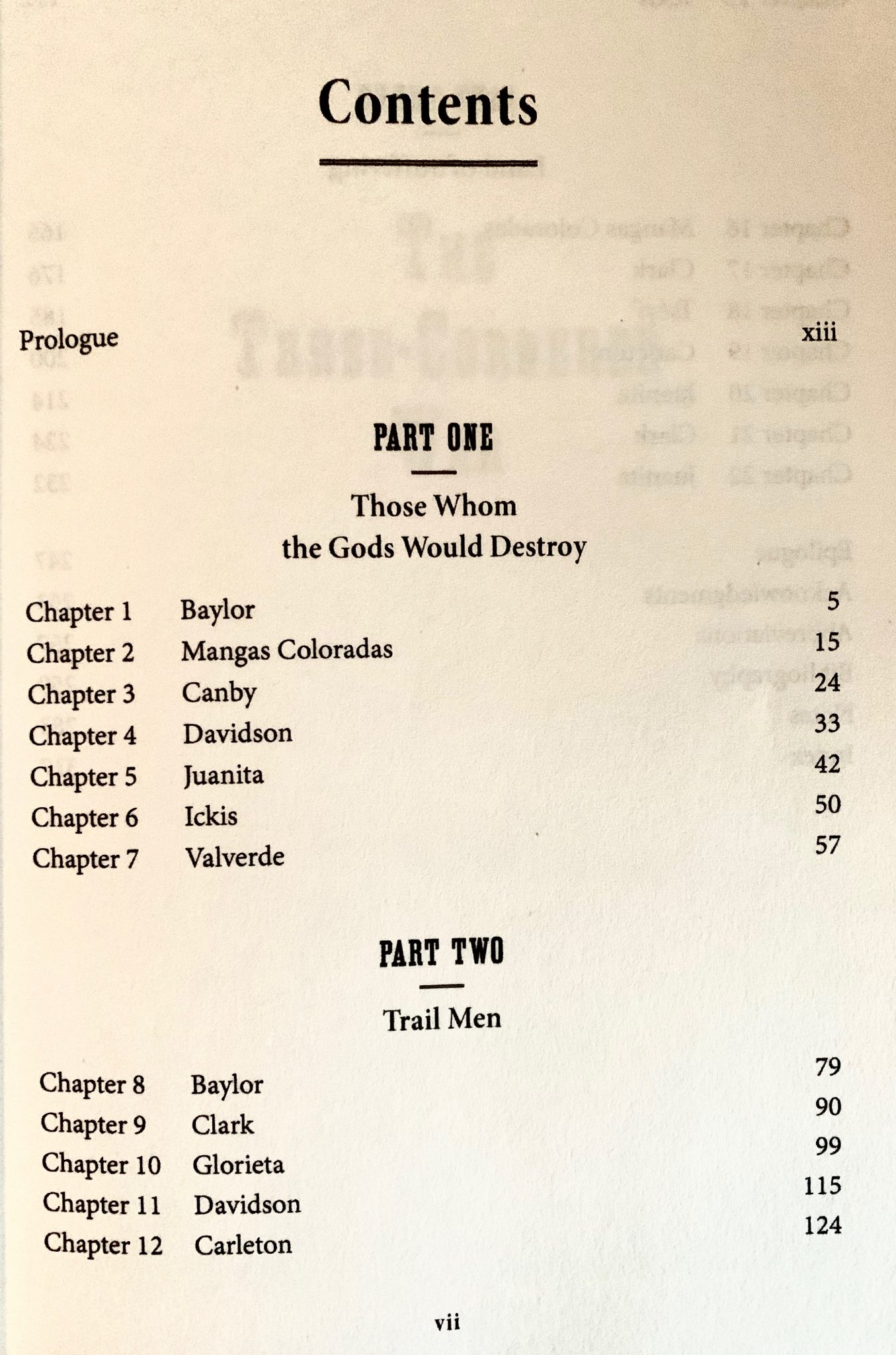When I left academia, my plan was to write a book that I had been thinking about for a while. A book that would tell the complicated story of the Civil War in the Southwest, a theater little-known in American culture and often overlooked (or outright dismissed) in histories of the conflict.
I knew that I could write this book in a traditional academic style: an introduction outlining arguments and historiography, a set of thematic chapters.
But I thought the project had trade book potential. And that meant writing in a new way, a narrative history style: chronological storytelling, with vivid descriptions and several central protagonists.
The war in the Southwest had many different moving parts. Conveying the fullness of its history would require, in the end, nine protagonists. When I began thinking about how I could possibly articulate all of their experiences, over seven years of warfare, and in a way that made sense to anyone, I turned not to models of history writing, but to fiction.
The source of my inspiration will probably strike you as anti-intuitive at best, and totally insane at worst. It was, dear reader, Game of Thrones.
***
I had watched the first season of the series, and started reading the novels. As I read, I was both appalled and intrigued. I’m not usually drawn to fiction that glorifies misogyny and violence, and yet George R.R. Martin had me turning those pages. How was this possible?
I considered the structure of the novels and it hit me: Martin was using multi-perspective narrative to pull me along. He would introduce one character in one place, then leap to another in the next chapter. The plot moved forward in time, but the narrative moved between characters. This meant that as a reader, I was in a constant state of anticipation. When would I find out what happened to Arya? When and how and where will these characters ultimately come together? At what point will I know how everything (and everyone) is related?

I wondered if it was possible to use this narrative strategy to interweave the experiences of the historical figures in my book. I decided it was. And I thought that it would be challenging—but also incredibly fun to write.
During two years of writing, I did a lot of experimenting and revising. I pulled apart chapters and put them back together again, in a different order. I researched and wrote nine different biographies, and used them to tell a larger story of the Civil War in the Southwest.
I cannot wait for readers to meet—and really get to know—the nine people who played such important roles in shaping the history of the Civil War West.
To give you a sense of who they are, I will be posting a short piece about each of them in the weeks leading up to the publication of The Three Cornered War: The Union, the Confederacy, and Native Peoples in the Fight for the West, in the order in which readers will encounter them.
It is my hope that The Three-Cornered War will illuminate dimensions of the Civil War that we don’t often think about, while also being a really good read. And that it will offer just one example of how historians can write history differently.
SPOILER ALERT: There are no dragons.
***
You can pre-order The Three-Cornered War (out on February 11, 2020) now at:



Featured image by Artush, via art.com.


Look forward to reading your book. This style of telling history was very successfuly employed by Michael Shaara in The Killer Angels and then by his son Jeff. I was fortunate to have had a class from Mike during which he would describe his technique in writing this history of the three days of Gettysburg. Very memorable time.
“Killer Angels” is definitely a classic – however, I believe it is classified a historical novel, rather than a history (it won a Pulitzer Prize for Fiction). “The Three-Cornered War” is different in that it is definitely history, but structured like a novel. In any case, I hope you do read it, and like it. Let me know what you think!
Advance reading copy in hand…looking forward to digging in next week.
Excellent! Can’t wait to hear what you think …
The new book looks amazing— just the kind of work that would draw people in while allowing you to show the complexity of multiple perspectives. I’ll have to get this!!
Thank you! I hope it will do both of those things. I’ll let you know if I’m coming out your way to talk about the book’s connections to California!
The description of your new work reminds me of the structure John Dos Passos used for his USA Trilogy: 42nd Parallel (1930), 1919 (1932) and The Big Money (1936). I am looking forward to your work’s upcoming publication.
I haven’t read any of the books in that trilogy! I will have to check them out.
I am very excited to read this. Does Kansas make an appearance?
Kansas does indeed appear! A few of the central figures go back and forth from the Southwest via Leavenworth and along the Santa Fe Trail …